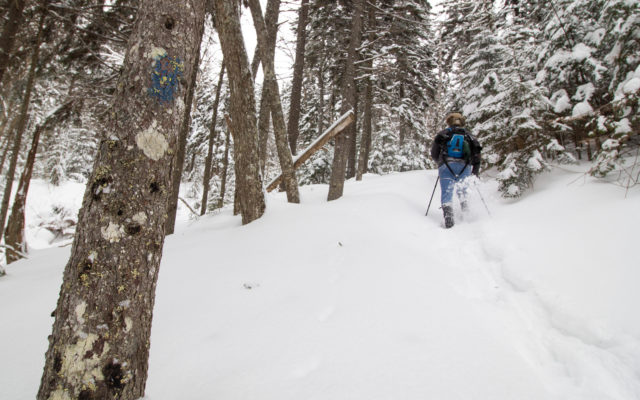
How to pick a trail that’s great for snowshoeing
I recently received two emails from readers looking for great places to snowshoe in Maine. They were looking for trail suggestions, and boy did I have a lot to say. Too much to say, really. So I decided to write a whole advice column on the topic.
Here are some things to consider when selecting a location to go snowshoeing in this beautiful state.
- Can you park at the trailhead?
In the winter, parking can be tricky. Throughout Maine, trailhead parking areas are often plowed, but not always. Furthermore, some roads remain unplowed all winter long, making it impossible to drive to certain trailheads. (This is the case with a number of hikes located off logging roads in the Moosehead area.) Therefore, when selecting a trail, do some research about plowing and parking. You can often find answers by calling the trail maintainer, such as a land trust or park ranger. Sometimes, if a trailhead parking area isn’t plowed, there’s room to park beside the road nearby, however, large snow banks will prevent you from being able to do this safely.
- How good are you at navigating?
Some trails are easier to follow in the winter than others. If you’re concerned about getting lost, then you should stick to trails that are well-marked with signs and blazes that are painted on tree trunks. I also suggest sticking below treeline. When trees become scarce or disappear entirely — for example, on the top of a bald mountain — the trail is usually marked with paint on the bedrock or with rock piles, known as cairns. Both of these trail markers disappear under the snow, which makes staying on trail impossible above treeline unless you already know the way or you’re using a GPS device and map.
- Consider visiting a popular trail.
Winter is a good time to experience some of the state’s most popular trails without dealing with the crowds of tourists. For this reason, I often visit Acadia National Park — the state’s most popular outdoor destination — in the winter. During the cold months, the trails of Acadia aren’t as congested as they are in the summer, but they’re still well traveled. As a result, many of the trails are packed down by snowshoers, which makes them easier to traverse and navigate.
- Check out state parks.
The Maine State Park System has made an effort in recent years to entice visitors to certain parks for winter recreation by hosting free events and occasional gear rental. Some of the most popular state parks for snowshoeing include Camden Hills State Park, Bradbury Mountain State Park, Holbrook Island Sanctuary State Park, Wolfe’s Neck Woods State Park and Mount Blue State Park.
- Numbers can be deceiving.
Don’t expect to be able to cover the same distance snowshoeing as you can hiking on solid ground. Snowshoeing is usually slower and more challenging. After all, it requires wrestling through snow. Everyone is different, but for me, a challenging snowshoe can be anywhere from 3 to 6 miles. But it also depends on snow conditions. In deep, fluffy snow, a 2-mile snowshoe could be exhausting. So when selecting a trail, keep that in mind. A small preserve featuring a 1-mile trail may be plenty to explore for one day.
- Snow conditions vary greatly throughout the state.
When it comes to selecting a snowshoeing location, snow conditions can be a deciding factor. In Maine, the snow is usually deeper in the north and in the western mountains than it is along the coast and down south, but that’s not always the case. It can be a challenge to find out snow conditions for a specific location in Maine unless it’s a ski mountain. I’ve called town offices to ask about snow depth before. I’ve also asked people on Facebook groups. But I usually just bring snowshoes and ice cleats, then decide which one I need when I get there.
- Trails are often shared.
Many winter trails are shared by snowshoers, cross-country skiers, fat-tire bicyclists and snowmobilers. If so, be aware of trail etiquette. Snowshoers are expected to stay off classic cross-country ski tracks, which are distinctive parallel lines grooved into the snow. They are also expected to keep their pets off those tracks. In addition, snowshoers should step to the side of the trail to allow skiers, bicyclists and snowmobilers to pass. If you’d feel more comfortable on a trail that is strictly for snowshoeing, you will need to do some research about trail guidelines. Tip: Narrow hiking trails are often for snowshoeing only, while wider trails are often open to more sports.
- Remember the day length.
Days are short during the winter in Maine. This is something you’ll need to take into account when planning your snowshoeing trip — unless you want to be snowshoeing in the dark. The day length should influence your decision when it comes to trail length and how far away the trail is located from your home. I also suggest you carry a headlamp, just in case.
- Seek out evergreens.
In the winter, I love visiting stands of evergreen trees, which are trees that keep their green needles year round. Their thick boughs offer shelter from cold wind and add a little green to the winter landscape. Plus, many varieties are fragrant. Pine, spruce, balsam fir, cedar, hemlock — I love them all, and so do the animals. Birds and squirrels often find shelter in these trees, and they’ll sing to you, or chatter at you, as you hike.
Follow Aislinn Sarnacki on Twitter: @1minhikegirl, and Instagram: @actoutdoors. Email her at asarnacki@bangordailynews.com. Her guidebooks “Family Friendly Hikes in Maine,” “Maine Hikes Off the Beaten Path” and “Dog-Friendly Hikes in Maine” are available at local bookstores and wherever books are sold.